Leadership and Management in Aged Care Sector Report Analysis
VerifiedAdded on 2020/04/07
|37
|10989
|35
Report
AI Summary
This report examines the crucial role of leadership and management in the aged care sector. It begins with an executive summary, highlighting the importance of effective leadership in healthcare settings, focusing on the need for efficient, safe, and affordable practices. The report analyzes leadership practices, emphasizing their impact on staff empowerment and job satisfaction, and identifies leadership development needs for nursing managers. It then provides a detailed literature review on leadership and management, specifically within the aged care context, followed by a presentation of research findings, including data on leadership skills, critical elements, and sources of support. The discussion section explores essential leadership skills and development needs in aged care organizations, leading to a conclusion and recommendations for enhancing leadership and management practices to improve patient care and organizational performance. The report includes figures illustrating key findings, such as years of experience in the sector, leadership skills and needs of leadership and management.

Running Head: Enhancing Leadership 1
Enhancing Leadership and management in Aged Care sector
Enhancing Leadership and management in Aged Care sector
Paraphrase This Document
Need a fresh take? Get an instant paraphrase of this document with our AI Paraphraser
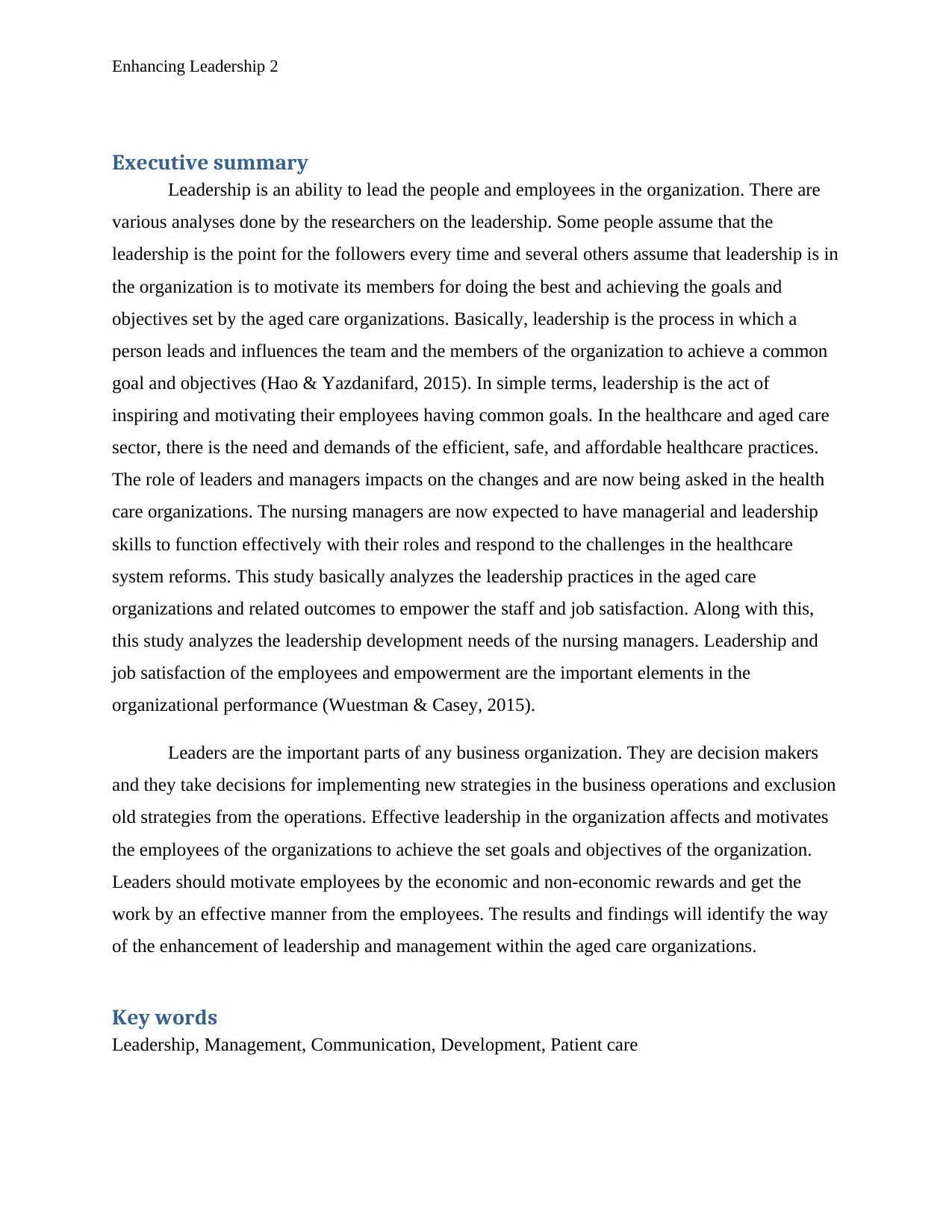
Enhancing Leadership 2
Executive summary
Leadership is an ability to lead the people and employees in the organization. There are
various analyses done by the researchers on the leadership. Some people assume that the
leadership is the point for the followers every time and several others assume that leadership is in
the organization is to motivate its members for doing the best and achieving the goals and
objectives set by the aged care organizations. Basically, leadership is the process in which a
person leads and influences the team and the members of the organization to achieve a common
goal and objectives (Hao & Yazdanifard, 2015). In simple terms, leadership is the act of
inspiring and motivating their employees having common goals. In the healthcare and aged care
sector, there is the need and demands of the efficient, safe, and affordable healthcare practices.
The role of leaders and managers impacts on the changes and are now being asked in the health
care organizations. The nursing managers are now expected to have managerial and leadership
skills to function effectively with their roles and respond to the challenges in the healthcare
system reforms. This study basically analyzes the leadership practices in the aged care
organizations and related outcomes to empower the staff and job satisfaction. Along with this,
this study analyzes the leadership development needs of the nursing managers. Leadership and
job satisfaction of the employees and empowerment are the important elements in the
organizational performance (Wuestman & Casey, 2015).
Leaders are the important parts of any business organization. They are decision makers
and they take decisions for implementing new strategies in the business operations and exclusion
old strategies from the operations. Effective leadership in the organization affects and motivates
the employees of the organizations to achieve the set goals and objectives of the organization.
Leaders should motivate employees by the economic and non-economic rewards and get the
work by an effective manner from the employees. The results and findings will identify the way
of the enhancement of leadership and management within the aged care organizations.
Key words
Leadership, Management, Communication, Development, Patient care
Executive summary
Leadership is an ability to lead the people and employees in the organization. There are
various analyses done by the researchers on the leadership. Some people assume that the
leadership is the point for the followers every time and several others assume that leadership is in
the organization is to motivate its members for doing the best and achieving the goals and
objectives set by the aged care organizations. Basically, leadership is the process in which a
person leads and influences the team and the members of the organization to achieve a common
goal and objectives (Hao & Yazdanifard, 2015). In simple terms, leadership is the act of
inspiring and motivating their employees having common goals. In the healthcare and aged care
sector, there is the need and demands of the efficient, safe, and affordable healthcare practices.
The role of leaders and managers impacts on the changes and are now being asked in the health
care organizations. The nursing managers are now expected to have managerial and leadership
skills to function effectively with their roles and respond to the challenges in the healthcare
system reforms. This study basically analyzes the leadership practices in the aged care
organizations and related outcomes to empower the staff and job satisfaction. Along with this,
this study analyzes the leadership development needs of the nursing managers. Leadership and
job satisfaction of the employees and empowerment are the important elements in the
organizational performance (Wuestman & Casey, 2015).
Leaders are the important parts of any business organization. They are decision makers
and they take decisions for implementing new strategies in the business operations and exclusion
old strategies from the operations. Effective leadership in the organization affects and motivates
the employees of the organizations to achieve the set goals and objectives of the organization.
Leaders should motivate employees by the economic and non-economic rewards and get the
work by an effective manner from the employees. The results and findings will identify the way
of the enhancement of leadership and management within the aged care organizations.
Key words
Leadership, Management, Communication, Development, Patient care
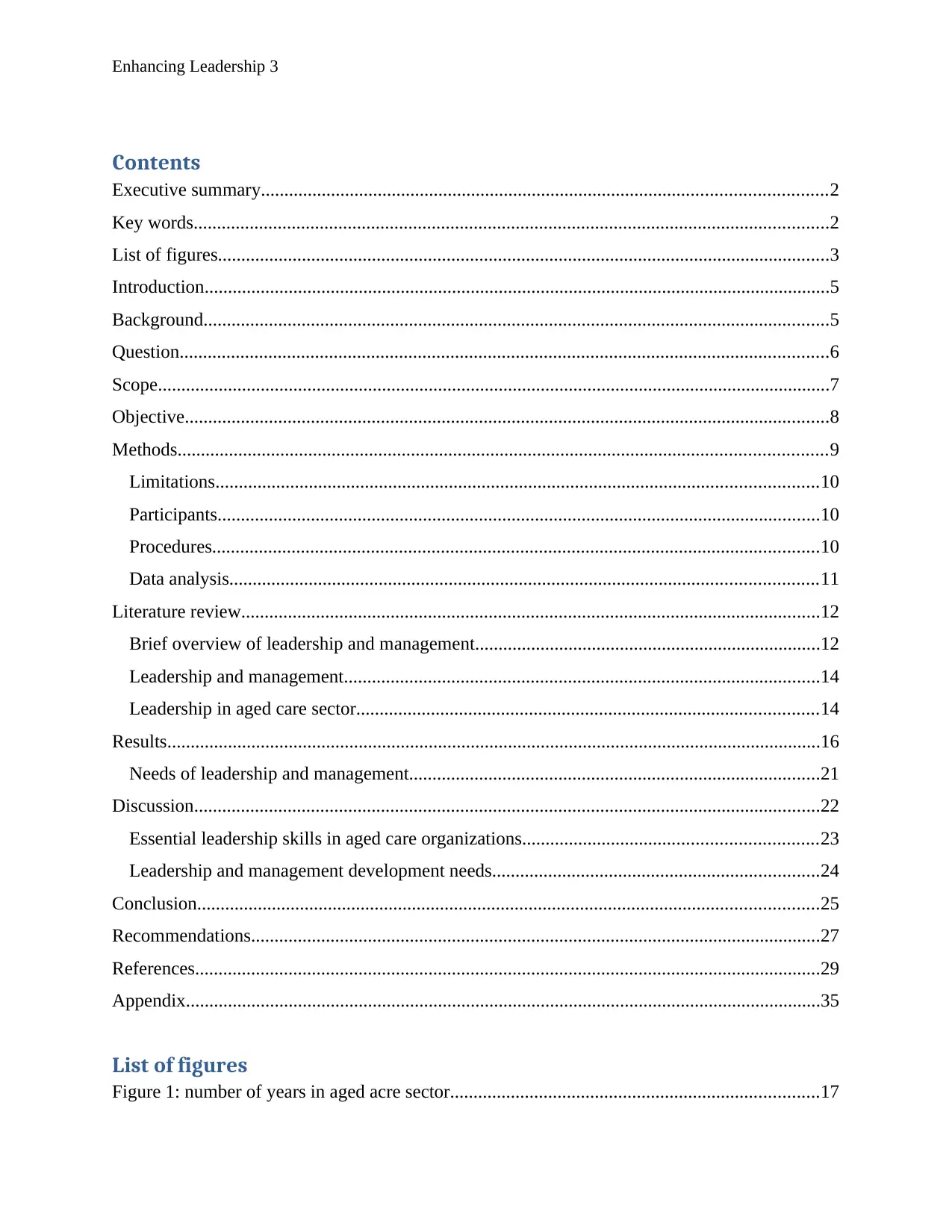
Enhancing Leadership 3
Contents
Executive summary.........................................................................................................................2
Key words........................................................................................................................................2
List of figures...................................................................................................................................3
Introduction......................................................................................................................................5
Background......................................................................................................................................5
Question...........................................................................................................................................6
Scope................................................................................................................................................7
Objective..........................................................................................................................................8
Methods...........................................................................................................................................9
Limitations.................................................................................................................................10
Participants.................................................................................................................................10
Procedures..................................................................................................................................10
Data analysis..............................................................................................................................11
Literature review............................................................................................................................12
Brief overview of leadership and management..........................................................................12
Leadership and management......................................................................................................14
Leadership in aged care sector...................................................................................................14
Results............................................................................................................................................16
Needs of leadership and management........................................................................................21
Discussion......................................................................................................................................22
Essential leadership skills in aged care organizations...............................................................23
Leadership and management development needs......................................................................24
Conclusion.....................................................................................................................................25
Recommendations..........................................................................................................................27
References......................................................................................................................................29
Appendix........................................................................................................................................35
List of figures
Figure 1: number of years in aged acre sector...............................................................................17
Contents
Executive summary.........................................................................................................................2
Key words........................................................................................................................................2
List of figures...................................................................................................................................3
Introduction......................................................................................................................................5
Background......................................................................................................................................5
Question...........................................................................................................................................6
Scope................................................................................................................................................7
Objective..........................................................................................................................................8
Methods...........................................................................................................................................9
Limitations.................................................................................................................................10
Participants.................................................................................................................................10
Procedures..................................................................................................................................10
Data analysis..............................................................................................................................11
Literature review............................................................................................................................12
Brief overview of leadership and management..........................................................................12
Leadership and management......................................................................................................14
Leadership in aged care sector...................................................................................................14
Results............................................................................................................................................16
Needs of leadership and management........................................................................................21
Discussion......................................................................................................................................22
Essential leadership skills in aged care organizations...............................................................23
Leadership and management development needs......................................................................24
Conclusion.....................................................................................................................................25
Recommendations..........................................................................................................................27
References......................................................................................................................................29
Appendix........................................................................................................................................35
List of figures
Figure 1: number of years in aged acre sector...............................................................................17
⊘ This is a preview!⊘
Do you want full access?
Subscribe today to unlock all pages.

Trusted by 1+ million students worldwide
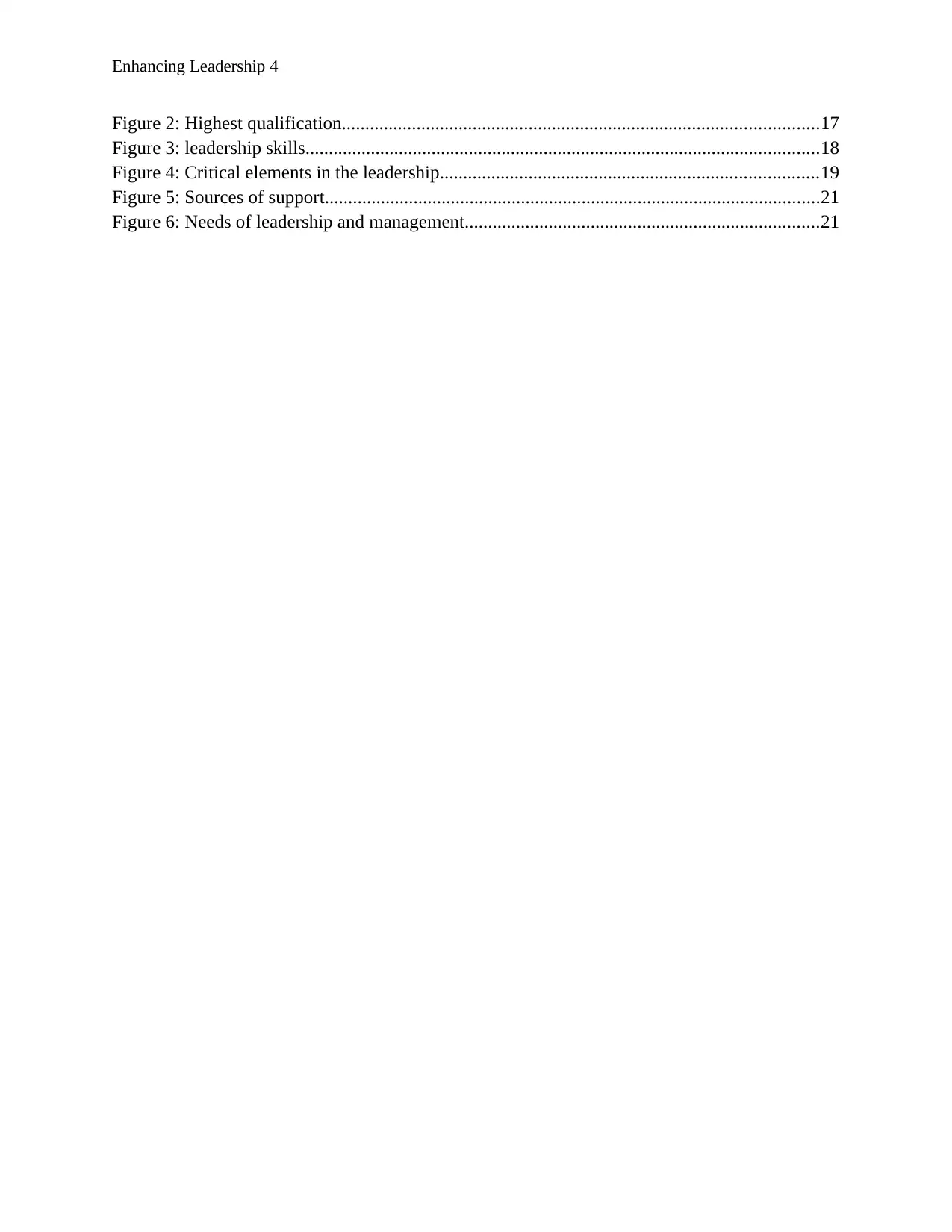
Enhancing Leadership 4
Figure 2: Highest qualification......................................................................................................17
Figure 3: leadership skills..............................................................................................................18
Figure 4: Critical elements in the leadership.................................................................................19
Figure 5: Sources of support..........................................................................................................21
Figure 6: Needs of leadership and management............................................................................21
Figure 2: Highest qualification......................................................................................................17
Figure 3: leadership skills..............................................................................................................18
Figure 4: Critical elements in the leadership.................................................................................19
Figure 5: Sources of support..........................................................................................................21
Figure 6: Needs of leadership and management............................................................................21
Paraphrase This Document
Need a fresh take? Get an instant paraphrase of this document with our AI Paraphraser
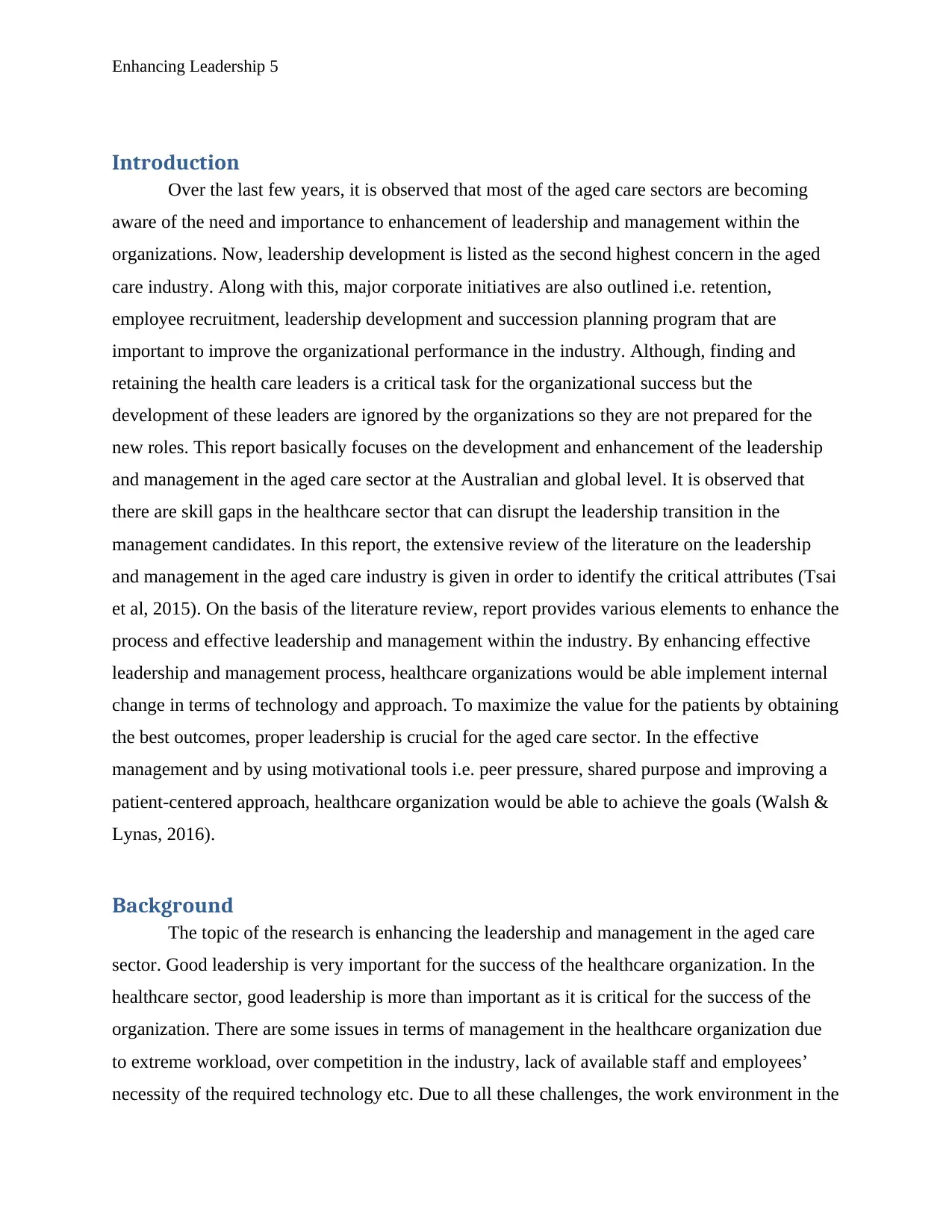
Enhancing Leadership 5
Introduction
Over the last few years, it is observed that most of the aged care sectors are becoming
aware of the need and importance to enhancement of leadership and management within the
organizations. Now, leadership development is listed as the second highest concern in the aged
care industry. Along with this, major corporate initiatives are also outlined i.e. retention,
employee recruitment, leadership development and succession planning program that are
important to improve the organizational performance in the industry. Although, finding and
retaining the health care leaders is a critical task for the organizational success but the
development of these leaders are ignored by the organizations so they are not prepared for the
new roles. This report basically focuses on the development and enhancement of the leadership
and management in the aged care sector at the Australian and global level. It is observed that
there are skill gaps in the healthcare sector that can disrupt the leadership transition in the
management candidates. In this report, the extensive review of the literature on the leadership
and management in the aged care industry is given in order to identify the critical attributes (Tsai
et al, 2015). On the basis of the literature review, report provides various elements to enhance the
process and effective leadership and management within the industry. By enhancing effective
leadership and management process, healthcare organizations would be able implement internal
change in terms of technology and approach. To maximize the value for the patients by obtaining
the best outcomes, proper leadership is crucial for the aged care sector. In the effective
management and by using motivational tools i.e. peer pressure, shared purpose and improving a
patient-centered approach, healthcare organization would be able to achieve the goals (Walsh &
Lynas, 2016).
Background
The topic of the research is enhancing the leadership and management in the aged care
sector. Good leadership is very important for the success of the healthcare organization. In the
healthcare sector, good leadership is more than important as it is critical for the success of the
organization. There are some issues in terms of management in the healthcare organization due
to extreme workload, over competition in the industry, lack of available staff and employees’
necessity of the required technology etc. Due to all these challenges, the work environment in the
Introduction
Over the last few years, it is observed that most of the aged care sectors are becoming
aware of the need and importance to enhancement of leadership and management within the
organizations. Now, leadership development is listed as the second highest concern in the aged
care industry. Along with this, major corporate initiatives are also outlined i.e. retention,
employee recruitment, leadership development and succession planning program that are
important to improve the organizational performance in the industry. Although, finding and
retaining the health care leaders is a critical task for the organizational success but the
development of these leaders are ignored by the organizations so they are not prepared for the
new roles. This report basically focuses on the development and enhancement of the leadership
and management in the aged care sector at the Australian and global level. It is observed that
there are skill gaps in the healthcare sector that can disrupt the leadership transition in the
management candidates. In this report, the extensive review of the literature on the leadership
and management in the aged care industry is given in order to identify the critical attributes (Tsai
et al, 2015). On the basis of the literature review, report provides various elements to enhance the
process and effective leadership and management within the industry. By enhancing effective
leadership and management process, healthcare organizations would be able implement internal
change in terms of technology and approach. To maximize the value for the patients by obtaining
the best outcomes, proper leadership is crucial for the aged care sector. In the effective
management and by using motivational tools i.e. peer pressure, shared purpose and improving a
patient-centered approach, healthcare organization would be able to achieve the goals (Walsh &
Lynas, 2016).
Background
The topic of the research is enhancing the leadership and management in the aged care
sector. Good leadership is very important for the success of the healthcare organization. In the
healthcare sector, good leadership is more than important as it is critical for the success of the
organization. There are some issues in terms of management in the healthcare organization due
to extreme workload, over competition in the industry, lack of available staff and employees’
necessity of the required technology etc. Due to all these challenges, the work environment in the

Enhancing Leadership 6
health care organizations is becoming complicated gradually. Thus, there is the need of effective
way and team work in the healthcare organizations in which managers can create strategic
leadership in the business. Healthcare sector is the subject of change for the development of the
various countries. In the continuous rise of competition, the quality of the health services is
major issue for the patients (Fitzgerald, 2015). For this manner, there is the need of appropriate
management and leadership skills to manage the operations within the healthcare sector.
Basically, leadership is identified as the important role in the healthcare consultant post.
Leadership in the aged care industry is important to implement the dictatorial management style
within the organizations. Leadership in the industry is crucial in which managers have the
responsibility to demonstrate the leadership qualities within the managerial role in the
organization. Aged care organizations must have the leadership expertise to implement the
change based on the decision- making process and patient-centered approach for care (Ganta and
Manukonda, 2014)
The quality of aged care organizations depends upon the effective and efficient use of the
resources. Proper management of the organization improves the efficiency of the operations and
help to ensure best use of the limited resources. The management of healthcare system is
recognized as the profession and people would be attracted by the profession. By the proper
management, organization would be able to have greater voice in the society and would achieve
improved population and patient health results (Swensen, 2015). The aged care organizations
face two main barriers in terms of professional management. The first one is the lack of proper
management and training among the healthcare leaders. Second one is that the role of the
managers and leaders is not recognized as the profession. So, there is the need of development of
effective leadership and management practices in the aged care sector to produce highly
competent managers in the organizations (Gibson & Mumford, 2013).
Question
The objective of this research is to understand the major factors that impact the leadership
in the aged care sector and organizations. Leadership is important for the success and growth of
the business in every industry. In the aged care, the objectives of the aged care organizations are
to provide high level of patients care and quality services to the users. The report is focused on
developing effective leadership and management in the aged care organizations based on the
health care organizations is becoming complicated gradually. Thus, there is the need of effective
way and team work in the healthcare organizations in which managers can create strategic
leadership in the business. Healthcare sector is the subject of change for the development of the
various countries. In the continuous rise of competition, the quality of the health services is
major issue for the patients (Fitzgerald, 2015). For this manner, there is the need of appropriate
management and leadership skills to manage the operations within the healthcare sector.
Basically, leadership is identified as the important role in the healthcare consultant post.
Leadership in the aged care industry is important to implement the dictatorial management style
within the organizations. Leadership in the industry is crucial in which managers have the
responsibility to demonstrate the leadership qualities within the managerial role in the
organization. Aged care organizations must have the leadership expertise to implement the
change based on the decision- making process and patient-centered approach for care (Ganta and
Manukonda, 2014)
The quality of aged care organizations depends upon the effective and efficient use of the
resources. Proper management of the organization improves the efficiency of the operations and
help to ensure best use of the limited resources. The management of healthcare system is
recognized as the profession and people would be attracted by the profession. By the proper
management, organization would be able to have greater voice in the society and would achieve
improved population and patient health results (Swensen, 2015). The aged care organizations
face two main barriers in terms of professional management. The first one is the lack of proper
management and training among the healthcare leaders. Second one is that the role of the
managers and leaders is not recognized as the profession. So, there is the need of development of
effective leadership and management practices in the aged care sector to produce highly
competent managers in the organizations (Gibson & Mumford, 2013).
Question
The objective of this research is to understand the major factors that impact the leadership
in the aged care sector and organizations. Leadership is important for the success and growth of
the business in every industry. In the aged care, the objectives of the aged care organizations are
to provide high level of patients care and quality services to the users. The report is focused on
developing effective leadership and management in the aged care organizations based on the
⊘ This is a preview!⊘
Do you want full access?
Subscribe today to unlock all pages.

Trusted by 1+ million students worldwide
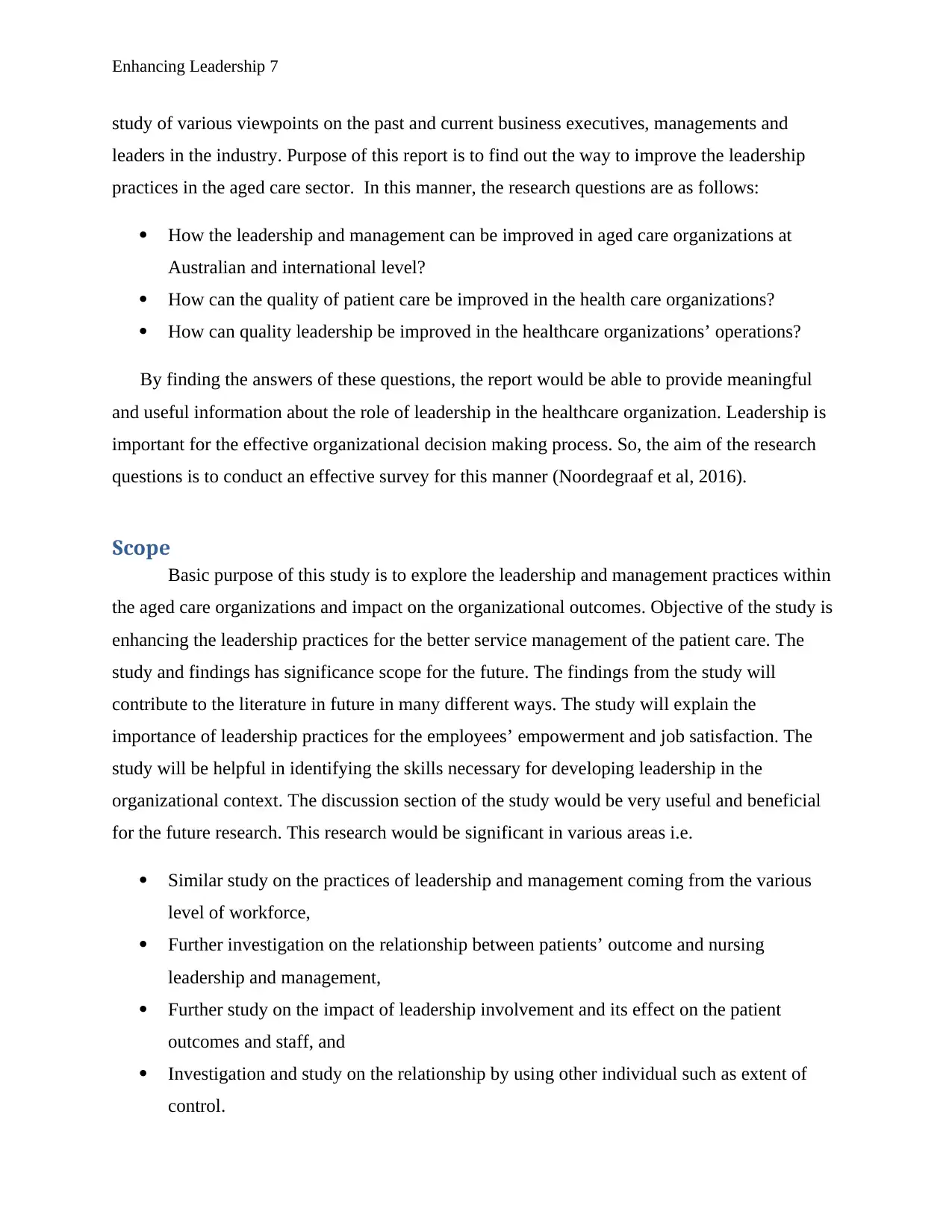
Enhancing Leadership 7
study of various viewpoints on the past and current business executives, managements and
leaders in the industry. Purpose of this report is to find out the way to improve the leadership
practices in the aged care sector. In this manner, the research questions are as follows:
How the leadership and management can be improved in aged care organizations at
Australian and international level?
How can the quality of patient care be improved in the health care organizations?
How can quality leadership be improved in the healthcare organizations’ operations?
By finding the answers of these questions, the report would be able to provide meaningful
and useful information about the role of leadership in the healthcare organization. Leadership is
important for the effective organizational decision making process. So, the aim of the research
questions is to conduct an effective survey for this manner (Noordegraaf et al, 2016).
Scope
Basic purpose of this study is to explore the leadership and management practices within
the aged care organizations and impact on the organizational outcomes. Objective of the study is
enhancing the leadership practices for the better service management of the patient care. The
study and findings has significance scope for the future. The findings from the study will
contribute to the literature in future in many different ways. The study will explain the
importance of leadership practices for the employees’ empowerment and job satisfaction. The
study will be helpful in identifying the skills necessary for developing leadership in the
organizational context. The discussion section of the study would be very useful and beneficial
for the future research. This research would be significant in various areas i.e.
Similar study on the practices of leadership and management coming from the various
level of workforce,
Further investigation on the relationship between patients’ outcome and nursing
leadership and management,
Further study on the impact of leadership involvement and its effect on the patient
outcomes and staff, and
Investigation and study on the relationship by using other individual such as extent of
control.
study of various viewpoints on the past and current business executives, managements and
leaders in the industry. Purpose of this report is to find out the way to improve the leadership
practices in the aged care sector. In this manner, the research questions are as follows:
How the leadership and management can be improved in aged care organizations at
Australian and international level?
How can the quality of patient care be improved in the health care organizations?
How can quality leadership be improved in the healthcare organizations’ operations?
By finding the answers of these questions, the report would be able to provide meaningful
and useful information about the role of leadership in the healthcare organization. Leadership is
important for the effective organizational decision making process. So, the aim of the research
questions is to conduct an effective survey for this manner (Noordegraaf et al, 2016).
Scope
Basic purpose of this study is to explore the leadership and management practices within
the aged care organizations and impact on the organizational outcomes. Objective of the study is
enhancing the leadership practices for the better service management of the patient care. The
study and findings has significance scope for the future. The findings from the study will
contribute to the literature in future in many different ways. The study will explain the
importance of leadership practices for the employees’ empowerment and job satisfaction. The
study will be helpful in identifying the skills necessary for developing leadership in the
organizational context. The discussion section of the study would be very useful and beneficial
for the future research. This research would be significant in various areas i.e.
Similar study on the practices of leadership and management coming from the various
level of workforce,
Further investigation on the relationship between patients’ outcome and nursing
leadership and management,
Further study on the impact of leadership involvement and its effect on the patient
outcomes and staff, and
Investigation and study on the relationship by using other individual such as extent of
control.
Paraphrase This Document
Need a fresh take? Get an instant paraphrase of this document with our AI Paraphraser
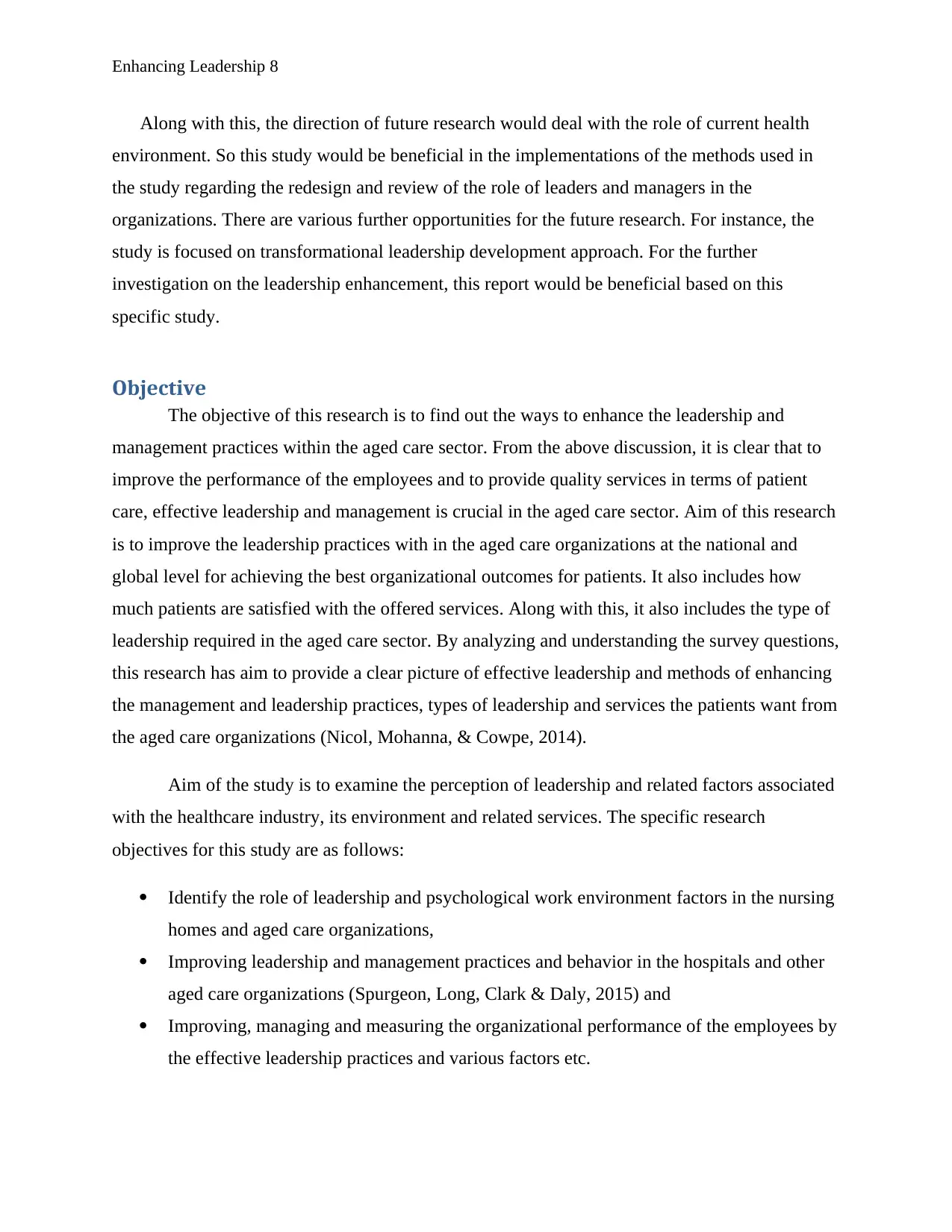
Enhancing Leadership 8
Along with this, the direction of future research would deal with the role of current health
environment. So this study would be beneficial in the implementations of the methods used in
the study regarding the redesign and review of the role of leaders and managers in the
organizations. There are various further opportunities for the future research. For instance, the
study is focused on transformational leadership development approach. For the further
investigation on the leadership enhancement, this report would be beneficial based on this
specific study.
Objective
The objective of this research is to find out the ways to enhance the leadership and
management practices within the aged care sector. From the above discussion, it is clear that to
improve the performance of the employees and to provide quality services in terms of patient
care, effective leadership and management is crucial in the aged care sector. Aim of this research
is to improve the leadership practices with in the aged care organizations at the national and
global level for achieving the best organizational outcomes for patients. It also includes how
much patients are satisfied with the offered services. Along with this, it also includes the type of
leadership required in the aged care sector. By analyzing and understanding the survey questions,
this research has aim to provide a clear picture of effective leadership and methods of enhancing
the management and leadership practices, types of leadership and services the patients want from
the aged care organizations (Nicol, Mohanna, & Cowpe, 2014).
Aim of the study is to examine the perception of leadership and related factors associated
with the healthcare industry, its environment and related services. The specific research
objectives for this study are as follows:
Identify the role of leadership and psychological work environment factors in the nursing
homes and aged care organizations,
Improving leadership and management practices and behavior in the hospitals and other
aged care organizations (Spurgeon, Long, Clark & Daly, 2015) and
Improving, managing and measuring the organizational performance of the employees by
the effective leadership practices and various factors etc.
Along with this, the direction of future research would deal with the role of current health
environment. So this study would be beneficial in the implementations of the methods used in
the study regarding the redesign and review of the role of leaders and managers in the
organizations. There are various further opportunities for the future research. For instance, the
study is focused on transformational leadership development approach. For the further
investigation on the leadership enhancement, this report would be beneficial based on this
specific study.
Objective
The objective of this research is to find out the ways to enhance the leadership and
management practices within the aged care sector. From the above discussion, it is clear that to
improve the performance of the employees and to provide quality services in terms of patient
care, effective leadership and management is crucial in the aged care sector. Aim of this research
is to improve the leadership practices with in the aged care organizations at the national and
global level for achieving the best organizational outcomes for patients. It also includes how
much patients are satisfied with the offered services. Along with this, it also includes the type of
leadership required in the aged care sector. By analyzing and understanding the survey questions,
this research has aim to provide a clear picture of effective leadership and methods of enhancing
the management and leadership practices, types of leadership and services the patients want from
the aged care organizations (Nicol, Mohanna, & Cowpe, 2014).
Aim of the study is to examine the perception of leadership and related factors associated
with the healthcare industry, its environment and related services. The specific research
objectives for this study are as follows:
Identify the role of leadership and psychological work environment factors in the nursing
homes and aged care organizations,
Improving leadership and management practices and behavior in the hospitals and other
aged care organizations (Spurgeon, Long, Clark & Daly, 2015) and
Improving, managing and measuring the organizational performance of the employees by
the effective leadership practices and various factors etc.
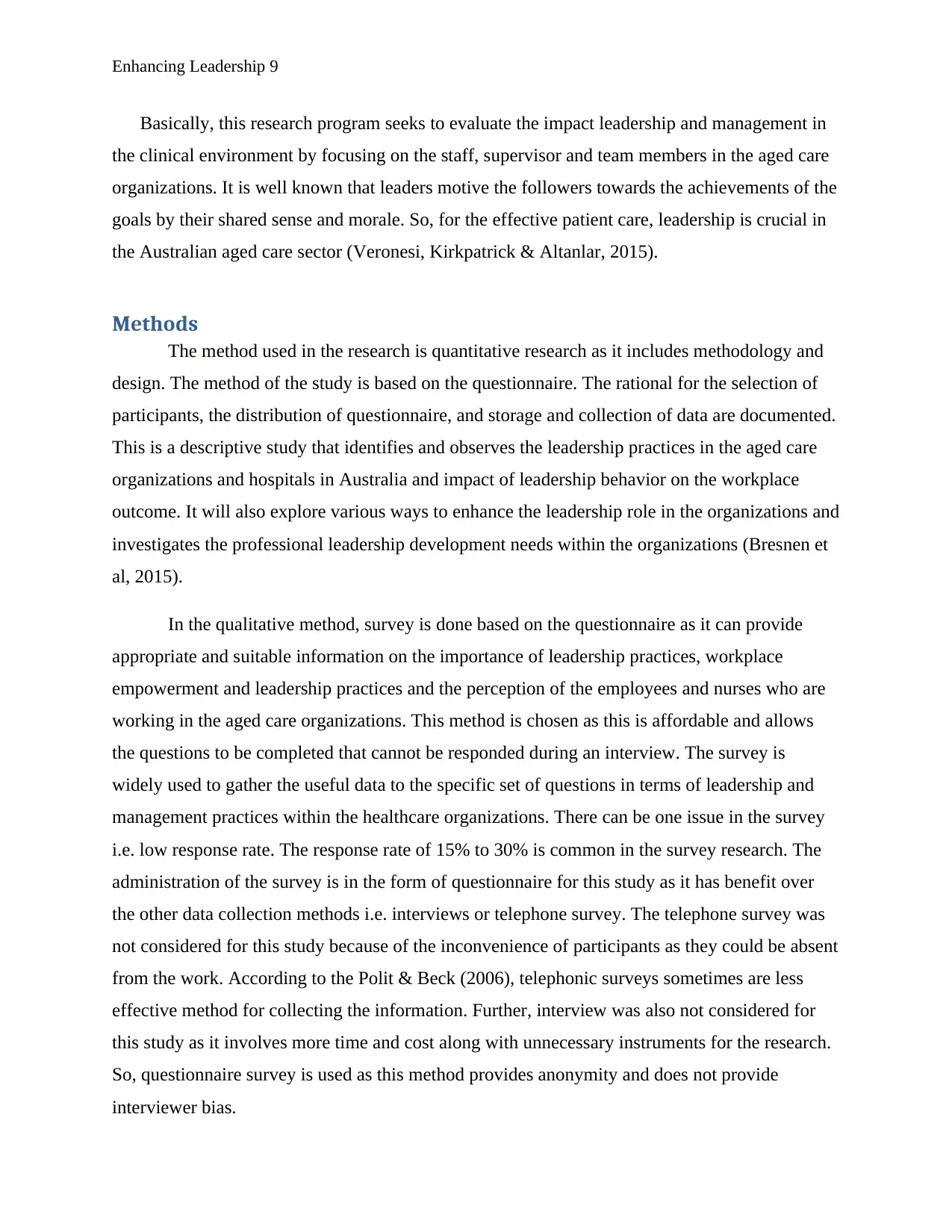
Enhancing Leadership 9
Basically, this research program seeks to evaluate the impact leadership and management in
the clinical environment by focusing on the staff, supervisor and team members in the aged care
organizations. It is well known that leaders motive the followers towards the achievements of the
goals by their shared sense and morale. So, for the effective patient care, leadership is crucial in
the Australian aged care sector (Veronesi, Kirkpatrick & Altanlar, 2015).
Methods
The method used in the research is quantitative research as it includes methodology and
design. The method of the study is based on the questionnaire. The rational for the selection of
participants, the distribution of questionnaire, and storage and collection of data are documented.
This is a descriptive study that identifies and observes the leadership practices in the aged care
organizations and hospitals in Australia and impact of leadership behavior on the workplace
outcome. It will also explore various ways to enhance the leadership role in the organizations and
investigates the professional leadership development needs within the organizations (Bresnen et
al, 2015).
In the qualitative method, survey is done based on the questionnaire as it can provide
appropriate and suitable information on the importance of leadership practices, workplace
empowerment and leadership practices and the perception of the employees and nurses who are
working in the aged care organizations. This method is chosen as this is affordable and allows
the questions to be completed that cannot be responded during an interview. The survey is
widely used to gather the useful data to the specific set of questions in terms of leadership and
management practices within the healthcare organizations. There can be one issue in the survey
i.e. low response rate. The response rate of 15% to 30% is common in the survey research. The
administration of the survey is in the form of questionnaire for this study as it has benefit over
the other data collection methods i.e. interviews or telephone survey. The telephone survey was
not considered for this study because of the inconvenience of participants as they could be absent
from the work. According to the Polit & Beck (2006), telephonic surveys sometimes are less
effective method for collecting the information. Further, interview was also not considered for
this study as it involves more time and cost along with unnecessary instruments for the research.
So, questionnaire survey is used as this method provides anonymity and does not provide
interviewer bias.
Basically, this research program seeks to evaluate the impact leadership and management in
the clinical environment by focusing on the staff, supervisor and team members in the aged care
organizations. It is well known that leaders motive the followers towards the achievements of the
goals by their shared sense and morale. So, for the effective patient care, leadership is crucial in
the Australian aged care sector (Veronesi, Kirkpatrick & Altanlar, 2015).
Methods
The method used in the research is quantitative research as it includes methodology and
design. The method of the study is based on the questionnaire. The rational for the selection of
participants, the distribution of questionnaire, and storage and collection of data are documented.
This is a descriptive study that identifies and observes the leadership practices in the aged care
organizations and hospitals in Australia and impact of leadership behavior on the workplace
outcome. It will also explore various ways to enhance the leadership role in the organizations and
investigates the professional leadership development needs within the organizations (Bresnen et
al, 2015).
In the qualitative method, survey is done based on the questionnaire as it can provide
appropriate and suitable information on the importance of leadership practices, workplace
empowerment and leadership practices and the perception of the employees and nurses who are
working in the aged care organizations. This method is chosen as this is affordable and allows
the questions to be completed that cannot be responded during an interview. The survey is
widely used to gather the useful data to the specific set of questions in terms of leadership and
management practices within the healthcare organizations. There can be one issue in the survey
i.e. low response rate. The response rate of 15% to 30% is common in the survey research. The
administration of the survey is in the form of questionnaire for this study as it has benefit over
the other data collection methods i.e. interviews or telephone survey. The telephone survey was
not considered for this study because of the inconvenience of participants as they could be absent
from the work. According to the Polit & Beck (2006), telephonic surveys sometimes are less
effective method for collecting the information. Further, interview was also not considered for
this study as it involves more time and cost along with unnecessary instruments for the research.
So, questionnaire survey is used as this method provides anonymity and does not provide
interviewer bias.
⊘ This is a preview!⊘
Do you want full access?
Subscribe today to unlock all pages.

Trusted by 1+ million students worldwide
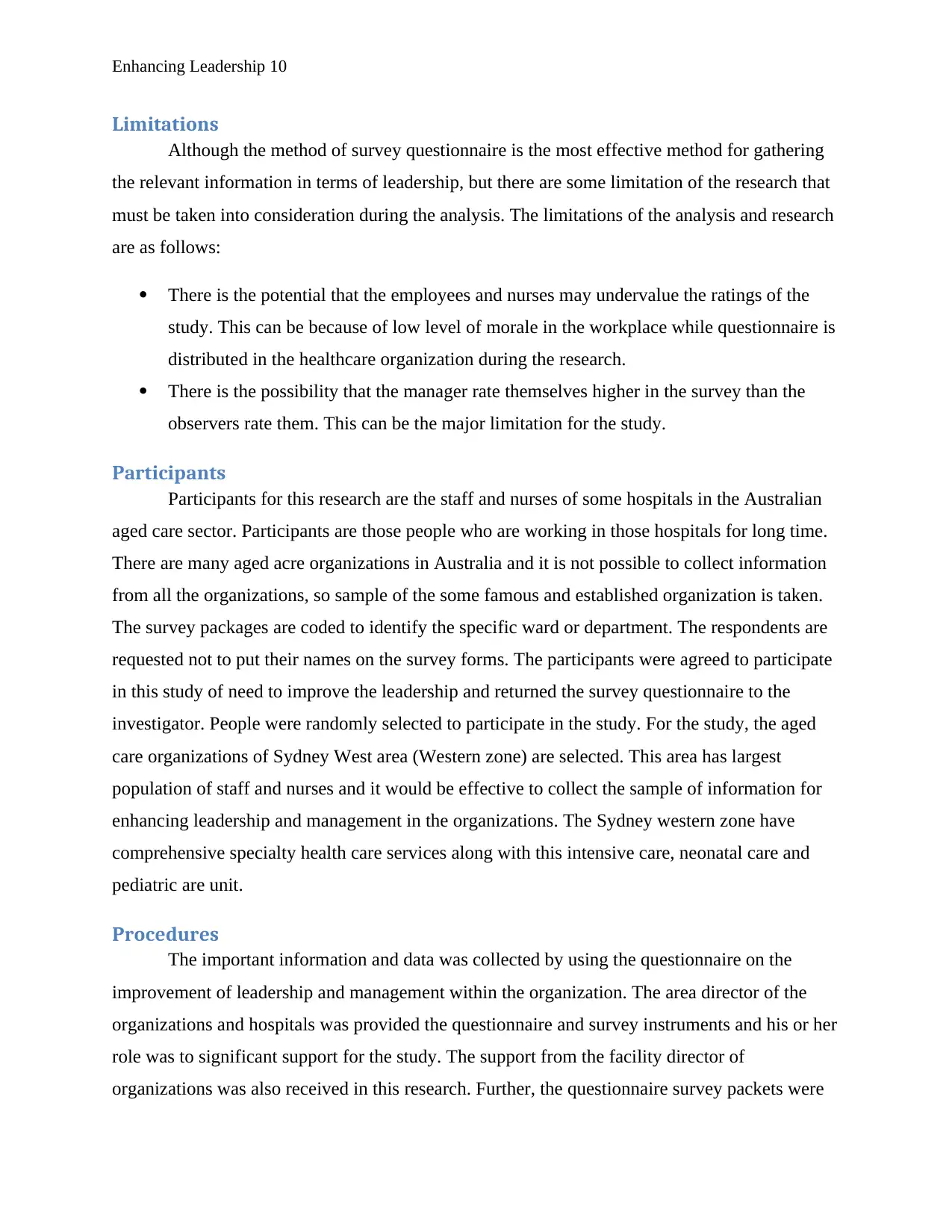
Enhancing Leadership 10
Limitations
Although the method of survey questionnaire is the most effective method for gathering
the relevant information in terms of leadership, but there are some limitation of the research that
must be taken into consideration during the analysis. The limitations of the analysis and research
are as follows:
There is the potential that the employees and nurses may undervalue the ratings of the
study. This can be because of low level of morale in the workplace while questionnaire is
distributed in the healthcare organization during the research.
There is the possibility that the manager rate themselves higher in the survey than the
observers rate them. This can be the major limitation for the study.
Participants
Participants for this research are the staff and nurses of some hospitals in the Australian
aged care sector. Participants are those people who are working in those hospitals for long time.
There are many aged acre organizations in Australia and it is not possible to collect information
from all the organizations, so sample of the some famous and established organization is taken.
The survey packages are coded to identify the specific ward or department. The respondents are
requested not to put their names on the survey forms. The participants were agreed to participate
in this study of need to improve the leadership and returned the survey questionnaire to the
investigator. People were randomly selected to participate in the study. For the study, the aged
care organizations of Sydney West area (Western zone) are selected. This area has largest
population of staff and nurses and it would be effective to collect the sample of information for
enhancing leadership and management in the organizations. The Sydney western zone have
comprehensive specialty health care services along with this intensive care, neonatal care and
pediatric are unit.
Procedures
The important information and data was collected by using the questionnaire on the
improvement of leadership and management within the organization. The area director of the
organizations and hospitals was provided the questionnaire and survey instruments and his or her
role was to significant support for the study. The support from the facility director of
organizations was also received in this research. Further, the questionnaire survey packets were
Limitations
Although the method of survey questionnaire is the most effective method for gathering
the relevant information in terms of leadership, but there are some limitation of the research that
must be taken into consideration during the analysis. The limitations of the analysis and research
are as follows:
There is the potential that the employees and nurses may undervalue the ratings of the
study. This can be because of low level of morale in the workplace while questionnaire is
distributed in the healthcare organization during the research.
There is the possibility that the manager rate themselves higher in the survey than the
observers rate them. This can be the major limitation for the study.
Participants
Participants for this research are the staff and nurses of some hospitals in the Australian
aged care sector. Participants are those people who are working in those hospitals for long time.
There are many aged acre organizations in Australia and it is not possible to collect information
from all the organizations, so sample of the some famous and established organization is taken.
The survey packages are coded to identify the specific ward or department. The respondents are
requested not to put their names on the survey forms. The participants were agreed to participate
in this study of need to improve the leadership and returned the survey questionnaire to the
investigator. People were randomly selected to participate in the study. For the study, the aged
care organizations of Sydney West area (Western zone) are selected. This area has largest
population of staff and nurses and it would be effective to collect the sample of information for
enhancing leadership and management in the organizations. The Sydney western zone have
comprehensive specialty health care services along with this intensive care, neonatal care and
pediatric are unit.
Procedures
The important information and data was collected by using the questionnaire on the
improvement of leadership and management within the organization. The area director of the
organizations and hospitals was provided the questionnaire and survey instruments and his or her
role was to significant support for the study. The support from the facility director of
organizations was also received in this research. Further, the questionnaire survey packets were
Paraphrase This Document
Need a fresh take? Get an instant paraphrase of this document with our AI Paraphraser

Enhancing Leadership 11
sent to all the selected participants. The questionnaire includes 20 questions that focuses on the
general information of participants along with the questions related to the need of leadership in
the organization. The participants were asked to fill the questionnaire completely and to return
them in the self-addressed to the researcher within 14 days. The list of all the participants is
prepared and the survey packets were coded prior for participants to ensure confidentiality. The
participants were instructed not to put their names and other details on the questionnaire. The
literature recommends some strategies to improve the response rate for the survey i.e.
redistribution of the questionnaire thanking to those who gave responses and reminder for the
non-respondents to return the questionnaire (Mascia, Russo, Dello, & Morandi, 2015).
Data analysis
For the process of data analysis, the content analysis is used for analyzing the responses
of the qualitative section of the questionnaire. Content analysis is used for the open-ended
questions which are available in the questionnaire. The qualitative responses in the open-ended
questionnaire are analyzed and categorized. There are following steps in the analysis of the
responses:
The responses are read again and again in order to provide an understanding and
familiarity with the text,
The catagories and themes are identified and frequencies are noted, and
The gathered information and data are reviewed to improve the reliability of the
subjective analysis (Hoption, 2014).
Basically, the method used for this study and research has aim to prepare research design,
data collection, instrumentation and identify methods of data analysis. The objective of this
research with the qualitative analysis is to explore effective leadership and management practices
in the various aged care organizations and the impact of leadership practices on the staff
satisfaction, patient care and workplace empowerment. Along with this, the follow-up is also
taken from the respondents. For this manner, the follow-up letter was sent to all the participants
who did not respond to the questions within 14 days. After the 14 days, one more follow-up was
sent to the non-respondents and provided more 7 days to submit the questionnaire. Further, the
discussion and result of the study is described in the report.
sent to all the selected participants. The questionnaire includes 20 questions that focuses on the
general information of participants along with the questions related to the need of leadership in
the organization. The participants were asked to fill the questionnaire completely and to return
them in the self-addressed to the researcher within 14 days. The list of all the participants is
prepared and the survey packets were coded prior for participants to ensure confidentiality. The
participants were instructed not to put their names and other details on the questionnaire. The
literature recommends some strategies to improve the response rate for the survey i.e.
redistribution of the questionnaire thanking to those who gave responses and reminder for the
non-respondents to return the questionnaire (Mascia, Russo, Dello, & Morandi, 2015).
Data analysis
For the process of data analysis, the content analysis is used for analyzing the responses
of the qualitative section of the questionnaire. Content analysis is used for the open-ended
questions which are available in the questionnaire. The qualitative responses in the open-ended
questionnaire are analyzed and categorized. There are following steps in the analysis of the
responses:
The responses are read again and again in order to provide an understanding and
familiarity with the text,
The catagories and themes are identified and frequencies are noted, and
The gathered information and data are reviewed to improve the reliability of the
subjective analysis (Hoption, 2014).
Basically, the method used for this study and research has aim to prepare research design,
data collection, instrumentation and identify methods of data analysis. The objective of this
research with the qualitative analysis is to explore effective leadership and management practices
in the various aged care organizations and the impact of leadership practices on the staff
satisfaction, patient care and workplace empowerment. Along with this, the follow-up is also
taken from the respondents. For this manner, the follow-up letter was sent to all the participants
who did not respond to the questions within 14 days. After the 14 days, one more follow-up was
sent to the non-respondents and provided more 7 days to submit the questionnaire. Further, the
discussion and result of the study is described in the report.
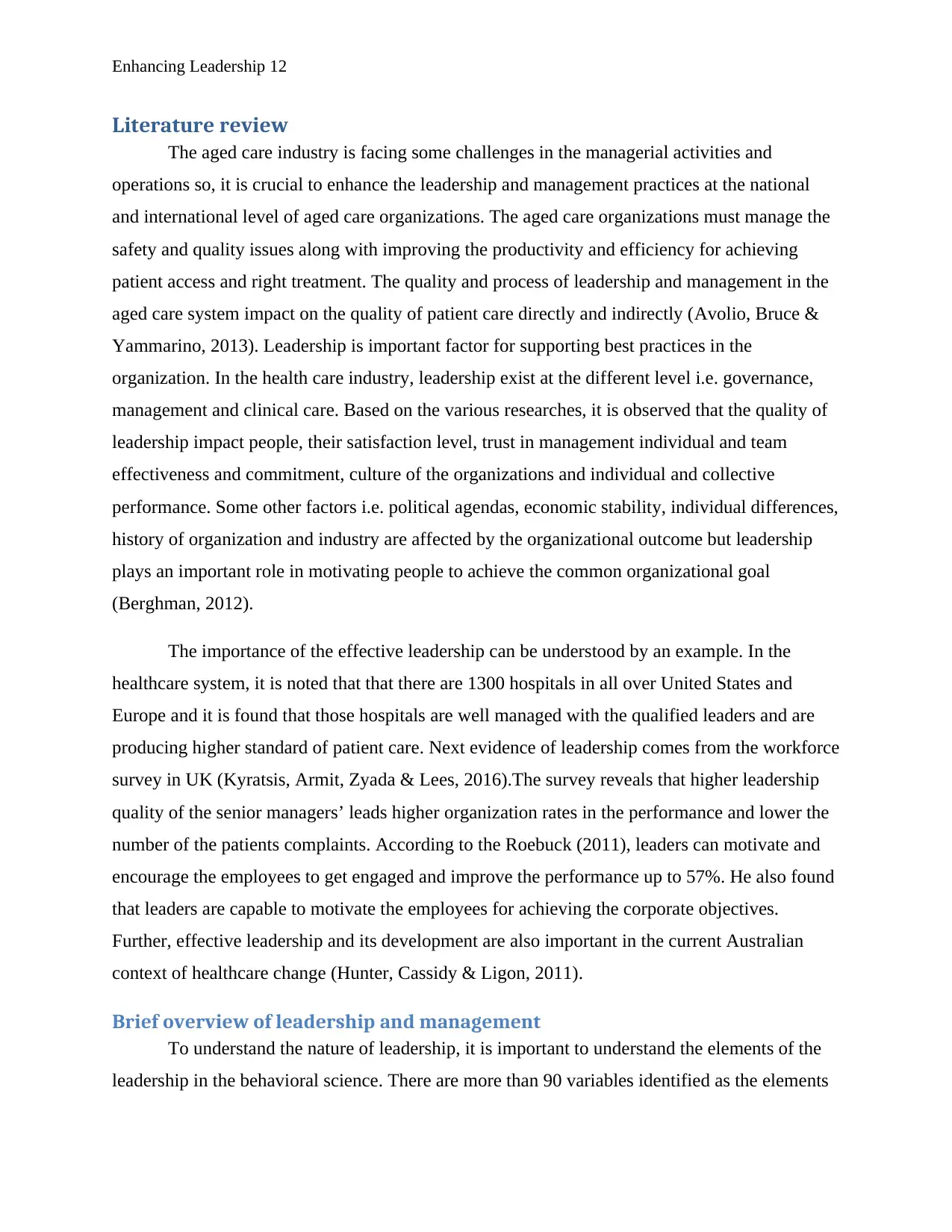
Enhancing Leadership 12
Literature review
The aged care industry is facing some challenges in the managerial activities and
operations so, it is crucial to enhance the leadership and management practices at the national
and international level of aged care organizations. The aged care organizations must manage the
safety and quality issues along with improving the productivity and efficiency for achieving
patient access and right treatment. The quality and process of leadership and management in the
aged care system impact on the quality of patient care directly and indirectly (Avolio, Bruce &
Yammarino, 2013). Leadership is important factor for supporting best practices in the
organization. In the health care industry, leadership exist at the different level i.e. governance,
management and clinical care. Based on the various researches, it is observed that the quality of
leadership impact people, their satisfaction level, trust in management individual and team
effectiveness and commitment, culture of the organizations and individual and collective
performance. Some other factors i.e. political agendas, economic stability, individual differences,
history of organization and industry are affected by the organizational outcome but leadership
plays an important role in motivating people to achieve the common organizational goal
(Berghman, 2012).
The importance of the effective leadership can be understood by an example. In the
healthcare system, it is noted that that there are 1300 hospitals in all over United States and
Europe and it is found that those hospitals are well managed with the qualified leaders and are
producing higher standard of patient care. Next evidence of leadership comes from the workforce
survey in UK (Kyratsis, Armit, Zyada & Lees, 2016).The survey reveals that higher leadership
quality of the senior managers’ leads higher organization rates in the performance and lower the
number of the patients complaints. According to the Roebuck (2011), leaders can motivate and
encourage the employees to get engaged and improve the performance up to 57%. He also found
that leaders are capable to motivate the employees for achieving the corporate objectives.
Further, effective leadership and its development are also important in the current Australian
context of healthcare change (Hunter, Cassidy & Ligon, 2011).
Brief overview of leadership and management
To understand the nature of leadership, it is important to understand the elements of the
leadership in the behavioral science. There are more than 90 variables identified as the elements
Literature review
The aged care industry is facing some challenges in the managerial activities and
operations so, it is crucial to enhance the leadership and management practices at the national
and international level of aged care organizations. The aged care organizations must manage the
safety and quality issues along with improving the productivity and efficiency for achieving
patient access and right treatment. The quality and process of leadership and management in the
aged care system impact on the quality of patient care directly and indirectly (Avolio, Bruce &
Yammarino, 2013). Leadership is important factor for supporting best practices in the
organization. In the health care industry, leadership exist at the different level i.e. governance,
management and clinical care. Based on the various researches, it is observed that the quality of
leadership impact people, their satisfaction level, trust in management individual and team
effectiveness and commitment, culture of the organizations and individual and collective
performance. Some other factors i.e. political agendas, economic stability, individual differences,
history of organization and industry are affected by the organizational outcome but leadership
plays an important role in motivating people to achieve the common organizational goal
(Berghman, 2012).
The importance of the effective leadership can be understood by an example. In the
healthcare system, it is noted that that there are 1300 hospitals in all over United States and
Europe and it is found that those hospitals are well managed with the qualified leaders and are
producing higher standard of patient care. Next evidence of leadership comes from the workforce
survey in UK (Kyratsis, Armit, Zyada & Lees, 2016).The survey reveals that higher leadership
quality of the senior managers’ leads higher organization rates in the performance and lower the
number of the patients complaints. According to the Roebuck (2011), leaders can motivate and
encourage the employees to get engaged and improve the performance up to 57%. He also found
that leaders are capable to motivate the employees for achieving the corporate objectives.
Further, effective leadership and its development are also important in the current Australian
context of healthcare change (Hunter, Cassidy & Ligon, 2011).
Brief overview of leadership and management
To understand the nature of leadership, it is important to understand the elements of the
leadership in the behavioral science. There are more than 90 variables identified as the elements
⊘ This is a preview!⊘
Do you want full access?
Subscribe today to unlock all pages.

Trusted by 1+ million students worldwide
1 out of 37
Related Documents
Your All-in-One AI-Powered Toolkit for Academic Success.
+13062052269
info@desklib.com
Available 24*7 on WhatsApp / Email
![[object Object]](/_next/static/media/star-bottom.7253800d.svg)
Unlock your academic potential
Copyright © 2020–2025 A2Z Services. All Rights Reserved. Developed and managed by ZUCOL.




